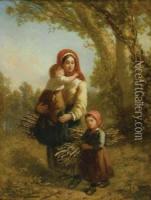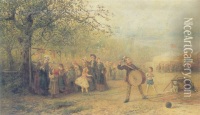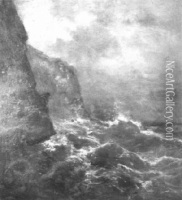James C. Thom Paintings
James Crawford Thom was a Scottish-American artist known for his genre paintings, which often depicted Scottish life, landscapes, and rural scenes. Born on November 9, 1835, in Paisley, Scotland, Thom immigrated to the United States with his family when he was still a child. They settled in New York, where Thom would eventually develop his artistic career.
Thom's early life in America was characterized by a struggle to balance work with his passion for art. He initially worked in a variety of jobs, including as a banknote engraver, which helped him to develop his fine technical skills. Eventually, his interest in painting led him to seek formal training. He studied under the tutelage of well-known artists of the time, such as James Hart and William Hart, who were brothers and prominent figures in the Hudson River School of painting.
Throughout his career, Thom became known for his attention to detail, his use of color, and his ability to evoke emotion in his depictions of everyday life. His works often reflected a sentimental and romantic view of rural scenes, which resonated with the tastes of the time. Thom's genre paintings were particularly popular, often featuring children and animals, and they were well received by both critics and the public.
Thom's success as an artist allowed him to travel back to Scotland, where he found inspiration in the countryside and the lives of the Scottish people. His Scottish heritage deeply influenced his work, and he became known for his authentic representations of Scottish life, which were nostalgic and idyllic.
Despite his immersion in Scottish themes, Thom remained active in the American art scene. He exhibited his work at the National Academy of Design in New York and was involved with other institutions, contributing to the cultural landscape of the United States during the late 19th century.
James Crawford Thom passed away on May 7, 1898, leaving behind a legacy of work that celebrated both his Scottish roots and his American experiences. His paintings are a testament to the genre painting tradition of the 19th century and continue to be appreciated for their historical and artistic value.



